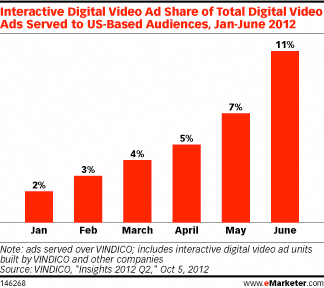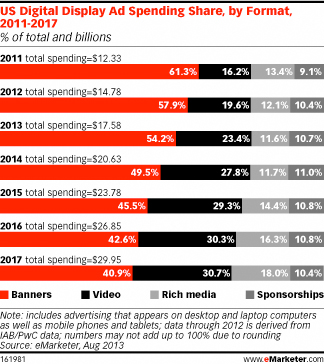Interactive Video Ads create Two-Way Communication
September 4, 2013
![]() When it comes to interactive video advertising, almost everyone is a newbie. That’s because, according to various rough estimates, only about 10% to 20% of all digital video ads have some kind of interactive component.
When it comes to interactive video advertising, almost everyone is a newbie. That’s because, according to various rough estimates, only about 10% to 20% of all digital video ads have some kind of interactive component.
For years, the term “interactive” has also been a synonym for online or digital. But these ads were really mostly static. Now, though, when applied to video advertising, the term interactive is used to describe some type of give-and-take, a two-way communication between advertisers and audiences, according to a new eMarketer report, “Interactive Video Advertising: Seven Best Practices for a New Ad Channel.”

It’s still the early days for interactive video advertising, but growth is rapid. As of June 2012, data from video ad management company VINDICO showed that 11% of all digital video ads had some kind of interactivity.
The share of ads that are interactive has doubled from last year, said Matt Timothy, president of VINDICO. “I expect it to double again in 2014.”

The sharp gains in digital video ad spending underline the importance of incorporating best practices into campaigns. eMarketer estimates that video’s share of the overall digital display budget will rise from 23.4% this year to 30.7% by 2017.
An understanding of the various ways marketers can make digital video ads interactive is the primary best practice when looking to get started with the process.
The following elements are all counted, by at least some, as contributing to interactive video. However, for some players in the space, not all of these elements are worthy of being called interactive:
A clickable button for engagement via Facebook, Twitter, Google+, Pinterest, and so forth
An ad selector, giving audience members a choice among multiple categories
A click, rollover or other user action that initiates further content
Some type of call to action within the video player, where the ad pauses and expands in a new window, with which the audience then interacts
An overlay, which can deliver anything from a two-question poll to rich media graphics or animation to an additional layer of video on top of the main advertising creative
The audience’s motivation for interaction can be to get more information—especially useful for high-consideration products—or to indulge in some kind of entertainment, like a game, movie preview or fun content.
It’s also important that an interactive video ad’s call to action vary depending on the type of product—and the audience—being pitched.
At this early stage, a few industries are gravitating more toward interactive video than others. Some, including automotive and electronics, take advantage of interactivity to provide deep information about product specs. Others, such as entertainment, have a lot of additional content to enhance interactivity. Ad executives also point to the travel, retail and consumer packaged goods (CPG) sectors as active in the space.
Courtesy of eMarketer































